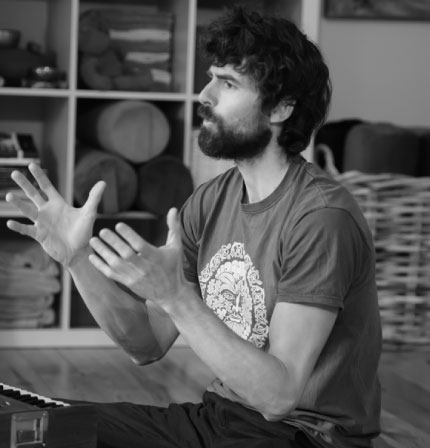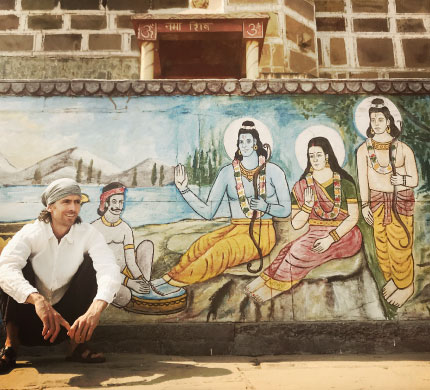
Making the Whole Field Sing
Bhagavad Gītā Chapter Two
Live Online Immersion
October 2024-May 2025
Bhagavad Gītā Chapter Two Live Online Immersion
Thirty meetings (two hour sessions with additional half hour recitation practice) October 2024 to May 2025
•In-depth study of the original Sanskṛt verses
•Develop a personal, living relationship with the time-proven teachings of the Gītā to support greater steadiness, discernment and resilience
•Cultivate resources to move skilfully through fear and limiting conditionings and transform obstacles into opportunities
•Deepen your understanding of the yogic vision and its practical application
Sometimes people say they wish there was a user’s manual for a human incarnation… there is!
It is called the Yoga śāstra and its time-proven, practical teachings are laid out in the Bhagavad Gītā, considered the distillation of all the Upaniṣadic wisdom.
The dialog of the Gītā provides us memorable, timeless support to live skillfully amidst the constant change and challenge of life.
The Gītā is a miracle mirror text. Every time we look into it, we can gain new, fresh insights. First though, we have to meet the text. There are probably hundreds of very meritorious translations of the Gītā, but the practical riches of the distilled Sanskṛt verses and the way their meaning reaches out in so many directions often defies translation.
On this course we will immerse ourselves in traditional, close study of the text, exploring it in the context of our day to day lives on a journey of ongoing self-empowerment and recovery.
This course will run from October 2024 to June 2025. Regular sessions will run Tuesday evenings 6-8pm UK time via zoom with optional recitation time beforehand 5:30-6:00pm. There may be occasional gatherings on a Saturday 4-6pm UK time.
Provisional course timings
Tuesdays 6:00-8:00pm UK time
Recitation pratice 5:30-6:00pm UK time
Autumn 2024: 10 sessions:
October 15,22,29, November 5,12,19,26, December 3
Saturday sessions 4:00-6:00pm UK time November 9,23
Spring 2025: 20 sessions: provisional dates/times
February 4,11,18,25, March 4, 11, 18, 25 April 1,8,15,22,29, May 6,13,20,27, June 3
Saturday sessions: February 8,22
Additional recitation practice sessions and possible satsang/inquiry gatherings may also be scheduled depending on the interests and availability of the group, for example during the winter break. We may have to rearrange two or three classes during the course and it is possible we continue for the first two weeks of June 2025. Occasional sessions may be scheduled on a Saturday 4-6pm UK time in case make-up classes are needed.
This longer program will give us chance to develop a personal relationship with the text and relate it to the broader teachings and day to day practice of yoga.
Those who would like to develop a recitation practice will be able to do this with more and more understanding of the text and the multiple layers of suggestive meaning encoded in the Sanskṛt.
Throughout the course, participants will have access to recordings of every session shortly after they are given, to recitation practice and resources and to study notes and resources.
Sessions will involve presentation, discussion and sometimes inquiry exercises and meditation practices.
Basic Session structure:
First half hour: optional recitation session
Then, two hour session, always interactive but working from this foundation:
60-90 minutes: presentation, 30-60 minutes discussion, inquiry and meditation exercises.
Course fee: £1280
Email james@jamesboagyoga.com for further inquries



Course fee: £1280
Or eight monthly payments of £160
Email james@jamesboagyoga.com with further inquiries.
Frequently Asked Questions
Is there a min/max group size?
-Yes, the course needs a minimum of twenty participants to run.
If there are times when the group is split up to do some small group work, would that part be cut out of the recordings?
-Whole group discussion will be recorded and available for everyone on the course to watch/listen/review.
If we are not able to join live on the zoom and we have burning questions after watching a recording, could we possibly email them to you?
Definitely. Throughout the course, participants are encouraged to email me questions/reflections between sessions which we can then explore in subsequent sessions.
How will class recordings and course materials be available/accessible?
All audio and video recordings of sessions are added to the online course portal directly after each session. All participants will have access to these along with any additional notes, inquiry exercises, and slides/images that are used for the duration of the course and through to the end of July 2025.
How would you accept payment from different countries?
The enrolment via the thinkific course portal usually works fine for international payments. It is also possible to make a one-off payment via Paypal or bank transfer if you prefer.
I appreciate the depth of learning and commitment behind offering such a course and think the fee is very reasonable, but it will be difficult for me to pay all at once, are payment plans available?
Yes, a monthly payment plan is available.
I am quite new to yoga. This course sounds quite advanced, will I be able to follow?
Yes, for sure! As more than one of my Indian teachers has said, the most important qualificaton for study or practice is the desire to do so. If you are interested in this course, it is likely an indication that it will serve you very well.
One of the beautiful things about the yogic texts is the way they meet us where we are. The miracle-mirror text of the Gītā is such that it offers us practical guidance and insight every time we look into it. Whether this is your very first contact with yoga texts and perspectives, or you have been studying for decades, it is always nourishing, supportive and revealing to dive into study of the Gītā.
Do you think we would walk away from this course with a better understanding of Sanskrit and translations?
100%. If you come to the sessions and read the materials, this is pretty much guaranteed. You will also receive fairly thorough notes on terminology. By the end of this course it is realistic that you will be able to relate to at least several key verses in the original Sanskṛt as we’ll have become well familiar with the reach and practical import of key Sanskṛt terms that defy translation. Through the course, you’ll be able to develop and deepen your own evolving understanding of the text and the principles it encodes so that consulting published translations can be useful rather than confining.
Talking of translations, are there any particular ones you recommend? Will we be working from an existing translation?
We will be working from the original Sanskṛt! The text will be provided. This will allow us to fashion our own dynamic, working translation and interpret the verses in ways that maintain their capacity to shine out their practical meaning, meet us where we are and give us useful guidance wherever we find ourselves..
With regards to recommended translations. There are many great resources available. If you are interested in getting closer to the Sanskṛt, the Winthrop Sargeant version with word by word analysis is very helpful.
Apart from that, there are many versions that are full of merit and it is often interesting to read several and compare. Paramahansa Yogananda’s translation with commentary, God Talks with Arjuna, in two volumes, is a wonderful resource. I know many people really appreciate the Stephen Mitchell and Eknath Easwaran versions.
I also recommend the translation by my teacher Tassanne Sinsakul and friend/colleague William S Whorton too, which distils lots of rich insight into a concise edition. Roopa Pai’s The Gītā for Children is a great resource too.
You mentioned that we will take time to develop a personal relationship with the text and the broader yoga teachings. I am quite new to the Eastern/Yogic/Indic world view. Is it realistic to do this over just sixty hours of study?
Good question! I think we can certainly start to do this! The Gītā is given in the middle of the battlefield – in the thick of the whirling wonder of life. Kṛṣṇa’s teachings are timeless and extraordinarily practical. People who have studied this chapter in depth with me before have commented, some of them now more than a decade on, how the course was life-changing, as it brought them into a totally different relationship with the Gītā, with yoga texts and ‘philosophy’ more broadly and with the bigger picture of yoga teachings.
I think of texts like the Gītā and the Yoga Sūtra as miracle mirror texts: every time we look into them, they can show us something new, help us come to fresh insight. This can happen as soon as we really meet the text and get acquainted with its essence.
Everything changed for me when I studied the text and heard my teacher present its teachings from within the tradition. Before that, it had felt somewhat distant. Even if translations are great, they still come imprinted with the translator’s own perspectives. Further, the nature of Sanskṛt is such that translations are very rarely able to communicate the many layers of meaning or the same nuance as the original. Working closely with the text over eight months, even if this is your first contact with yoga texts, given the content, I think it is realistic to say that you will complete the course with a solid grounding in the core concepts and principles that inform yoga practice and perspective.
